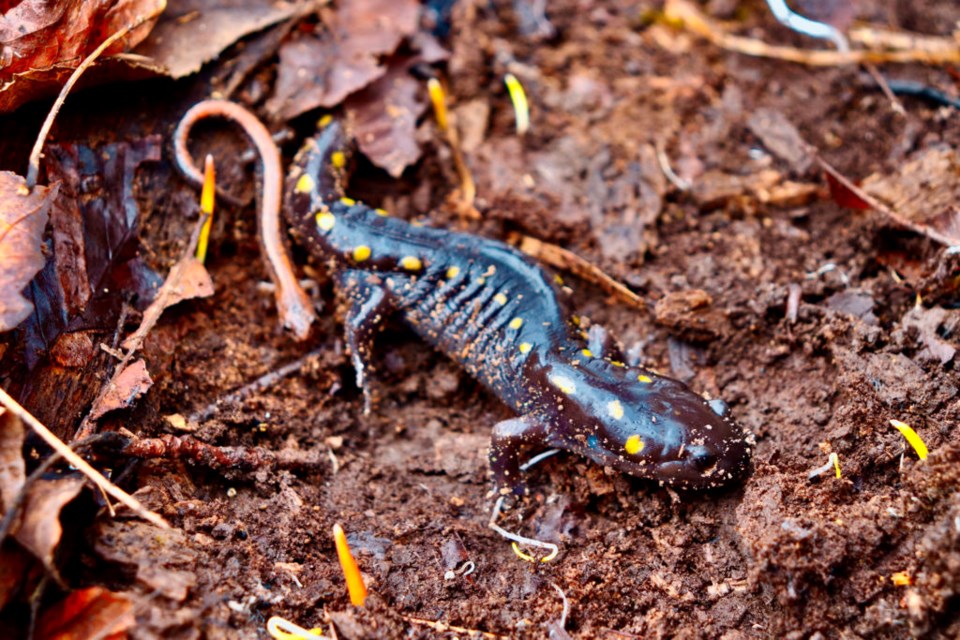
The bright, yellow spots of this spectacular creature leap off its slimy skin.
As I rolled the log over, a large black salamander riddled with yellow polka dots lays squat. I can count on one hand the number of times I’ve come across this memorable species of mole salamander, simply named the spotted salamander (Ambystoma maculatum).
This was last weekend, out on another trip that found me with my girlfriend in the depths of Backus Woods, near the shore of Lake Erie.
The first time I encountered one of these superb salamanders was when I was barely old enough to remember it. Yet, it was unforgettable. I was maybe six years old. My Dad (Moe) wanted to take me hiking, so he invited his coworker and friend, nicknamed Crow, out for a local Niagara Escarpment adventure. Crow was talked up as an avid salamander enthusiast, and he still lives true to that title today.
The three of us delicately searched the trailsides under waterlogged logs and flat stones. What I remember most vividly was the moment those bright yellow “lights” flashed up from the dark soil. Crow had found one, and as a budding nature enthusiast before I even knew it, I was hooked for a lifetime to see what else is out there. Nothing looks quite like a spotted salamander.
Since then, I have seen just three others at different locations in southern Ontario. These amphibians live and love where old growth forests grow on mounds of land. They like these hills adjacent to stagnant wetlands in their various valleys. All in all, it’s an increasingly hard combo to come by in southern Ontario.
This is exactly the type of habitat scenario you can find out toward Backus Woods and Long Point, which I have made a habit of exploring during the onset of spring conditions.
From this exact time last year, I remember where I discovered a small, pinky-finger sized juvenile of the spotted salamander. It was tiny, but provided a huge sign that big, chubby adults were in the area. That’s the one you see pictured with this article, which was found after selectively searching the same area where we found last year’s little one. Populations of these creatures tend to remain in a certain geographical area which specifically suits their habitat needs.
Emphasis might be put on the word “needs.” Spotted salamanders have relatives of the same family, like the blue-spotted salamander and Jefferson salamander. This robust trio of mole salamanders all share the same requirements of habitat. Humans simply can’t recreate the soil composure and habitat features that thousands of years of uninterrupted processes yield.
I found another spotted salamander on this trip, roughly one-third the mass of the one pictured, but even more vividly spotted. The expression of brighter and more vivid colouration is common across younger reptiles and amphibians around the globe.
What strikes me more than the fascinating colours is the power of a story from my childhood. That curiosity has carried forward over the years, and it keeps me looking for those heart-racing finds. It’s important to locate and recognize where certain species are for the sake of environmental knowledge and conservation. It’s equally important to take a moment and look at this alien-like creature, which is actually much more earth-like than you. It’s a distinguished moment when you share time and space with such a living thing.
I pick up the salamander while my partner holds the log back. I am purposeful to muddy my hands with the surrounding soil, so I can minimize any potential skin damage to the sensitive being, which absorbs both water and nutrients through its skin. The log is placed back without squishing the virtuous vertebrate, and I remark, how can a creature the size of your hand keep propelling you into worlds that are thousands of acres in size?
Even if you don’t find the salamander you’re looking for, it’s a lot like golfing or fishing. You can score really poor at golf, or perhaps catch no fish, but you can still have the happiest day out. The outdoors environment is constantly rewarding curious minds with its plot twists and beautiful seasonal changes. I believe that when I look back to the specific afternoon hike with my Dad and Crow as a kid, it was that moment which led me to the biggest and best salamander find in my life a few days ago.
Did I mention the epic canoeing routes, sandbank cookouts, and hundreds of acres to yourself? Those are just some of the things that came packaged with the hunt for a spotted salamander.
We do have a resident population here in Niagara-on-the Lake. It is small, and likely genetically isolated from other “spotties.” With continued habitat degradation of lands surrounding the Niagara Escarpment, their future as NOTL residents looks bleak at this rate.
With moments of discovery come moments of appreciation for our natural surroundings, and we may find ourselves surprised at where we end up next because of it.


